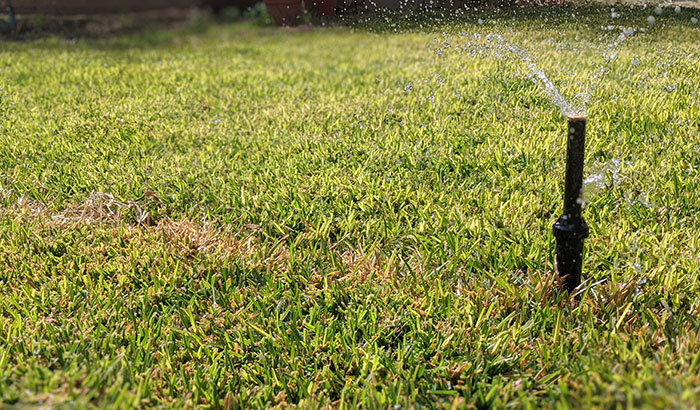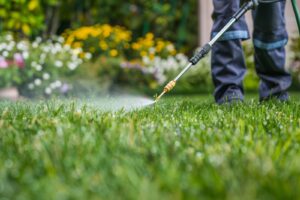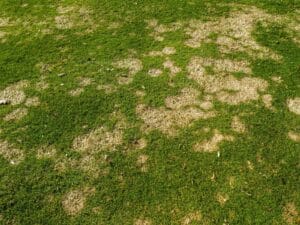Crabgrass can easily infiltrate a beautiful, curated lawn, so you should take care of it quickly before it becomes a huge problem.
Crabgrass is a warm-season annual grass that homeowners loathe. It gets its name because it grows in clumps with stems radiating from the center, resembling crab legs. Little tufts of this fast-growing wild grass can spread like wildfire, creating trip hazards and destroying your lawn.
Need to defend your yard from crabgrass? Here is a guide to help you get rid of this nasty weed so you can enjoy your turf again.
What Is Crabgrass?
Contrary to its name, crabgrass is neither a type of grass nor a sea-dwelling crustacean. Instead, since crabgrass is an annual warm-season weed, it will spread wherever it can get sunlight, water, and bare soil.
Crabgrass thrives in the heat. Once the soil temperature has remained above 55 to 60 degrees Fahrenheit for more than a week, you’ll notice it popping up in yards as early as March and April.
What Does Crabgrass Look Like?
Crabgrass resembles a clump of coarse, light-green grass. Its slender stems resemble a crab’s legs. It is frequently confused for fescue grass; however, color and size are helpful distinguishing characteristics. Tall fescue grass often has a darker green color, is dense, and develops quickly. Young crabgrass has blades that are roughly the thickness of a pencil, but as the stems get heavy, fall, and become scraggly, you’ll discover a star pattern in the middle.
Types of Crabgrass
There are two different types of crabgrass– hairy and smooth. The following information can help you decipher which type is overtaking your crabgrass lawn:
- Smooth – Around the sheath of the leaves of smooth crabgrass, there are no hairs. Only the auricles of smooth crabgrass have hairs. Because it grows more quickly, smooth crabgrass is sometimes known as “little crabgrass.” Although it can reach a height of six inches, it is often shorter than the other kind. It also has a pointy tip on the leaf blades. The plant’s stems slant at their nodes and occasionally become red.
- Hairy – Long crabgrass is another name for hairy crabgrass. Although hairy crabgrass tends to grow longer than smooth crabgrass, its leaf blades can reach up to six inches. The term “hairy kind” is because the plant is covered in numerous microscopic hairs if you look closely at its leaves and stems. In comparison to smooth crabgrass, it’s coarser with wider blades. While the leaves of smooth crabgrass are only approximately 1/4 inch wide, hairy crabgrass can be up to 1/2 inch wide.
How to Eradicate Crabgrass
This weed can develop in a few isolated spots, even on the healthiest lawn. If you’re wondering how to get rid of crabgrass quickly, immediate control is the ideal course of action. Postponing action raises the likelihood of seeds, which can persist for years and frustrate you even after you believe the issue has been resolved.
The best technique to handle crabgrass is with pre-emergent herbicides, along with routine mowing to deprive the weeds of their food source while promoting the other grasses to grow thicker.
If you don’t want to use chemicals, crabgrass should be eradicated as early in the spring as possible. Young patches will start to sprout in the late winter and early spring as soon as the soil temperature hits 55 degrees Fahrenheit. Because its roots won’t be as deep at this time, it will be simpler to dig out the plant before it can spread manually.
After getting rid of any existing crabgrass, you should over-seed those areas to encourage the growth of fresh grass. Unfilled spaces are ideal for the emergence of new crabgrass plants. In the sun, crabgrass grows and perishes. Keep your grass lush and healthy so it can help you out by preventing the growth of new weeds.
How to Prevent Crabgrass?
We’ve shared some tips for treating a crabgrass lawn, but we all know that prevention is how to get rid of crabgrass effectively.
Here are some tips to prevent this pesky weed from growing in the first place:
- Pre-emergent – Pre-emergent can answer the question: how can I get rid of crabgrass? Pre-emergent herbicides destroy crabgrass roots before they reach the soil’s surface. Make careful to pick a pre-emergent that is made for grassy weeds, like crabgrass. While some pre-emergent only operate on broadleaf weeds, others are effective on both kinds. Most solutions can be applied to any area of the lawn or flower beds. The majority are granular, so spread them out with a spreader and then water them in. This is general advice; for further directions, see the label on your product.
- Fertilize – Keep everything in top condition by fertilizing your lawn. To start, have your soil tested to determine its health and see what nutrients it might require. Then, apply a suitable conventional or organic fertilizer to keep your grass thick and full. Fertilizer will help get rid of your crabgrass-infested lawn.
When Is the Best Time to Treat Crabgrass?
Timing is key in the fight against crabgrass and other grassy plants. As the weather warms up with spring’s arrival, crabgrass roots might already be infiltrating your lawns covertly. The only way to prevent these weeds from sprouting later is to ensure that you stop them now. The easier it is to prevent and the better the outcomes, the earlier you treat. Prevent problems by applying pre-emergent treatment to your lawn before the warm spring weather causes the crabgrass seeds to sprout.
Call Summit Lawn and Pest Control
If you want to get rid of crabgrass for good, Summit Lawn & Pest Control is here to help! We are committed to offering quick and economical residential lawn care and pest control services so that you can enjoy your property once again. Schedule your free assessment with Summit Lawn & Pest Control now! We service Lehi, American Fork, Provo, Spanish Fork, and the rest of Utah County.







